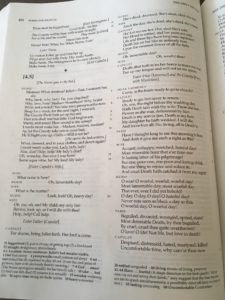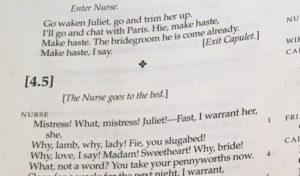I’ve attached a passage from Act I of King Lear, from two different editions of the play. I first selected Harvard Classic’s edition of King Lear. Charles W. Eliot started the Harvard Classics anthologies in order to create a sort of reading course easily available to anyone interested in receiving a general liberal education. He selected what he considered some of the most important literary texts, including many of Shakespeare plays. In the edition of Elizabethan Drama, which includes Marlowe and Shakespeare, Eliot wrote brief general introductions to each play and some footnotes. However, the edition is troublesome because it eliminates line numbers and most footnotes are merely definitions of terms. In general, this edition is not very helpful for scholars or literature students. Nonetheless, while going through the first scene of King Lear, I was drawn to one peculiar footnote about line 82 (based on H.H. Furness’ edition of the play), when King Lear addresses Cordelia and asks her to speak about her love. Eliot remarks that the Quarto reading of this line is “Although the last, not least in our dear love” instead of the Folio’s version he used, “although our last and least, to whose young love”. Being fairly familiar with Laurence Olivier’s (1983) and Ian McKellen’s (2008) interpretation of King Lear, used to hearing them both say “our last, but not least”, I am intrigued about the reason behind the different editions of this particular line and what it means.
Looking at Horace Howard Furness’ edition of the play, which includes long footnotes and seems to be more useful for scholars and students, I noticed that there is a lot of debate about this line. Furness quotes several critics such as Malone, Dyce, Staunton, White, Hudson, Schmidt, and others. According to Malone, the correct formula should have been “last not least” as it is applied to people highly valued to the speaker, and Cordelia is clearly Lear’s preferred child. However, White explain that in King Lear, “least” is used to allude to the personal traits and family positions of Cordelia, the fact that she is Lear’s youngest child. In this sense, Furness explains, the Folio formula is more accurate for it demonstrate that Cordelia was “her father’s little pet, while her sisters were big, bold, brazen beauties” (p. 14). Furness also discusses how according to Schmidt certain performances of the play might have influenced the reprinting and alterations of this line. At the end, Furness gives his own opinion, leaning towards the Folio’s formula being more in accordance with the nature of the play and the relationship between Lear and Cordelia.
I’d be interested to write about other possible readings of this line and its different variations, since I always took for granted that the correct formula is “last, but not least”, thinking that the Folio’s formula must have been a printing mistake (another possible explanation, according to Dyce and Staunton). Furness’ notes seems to be a good starting point to research this topic, but it’d be interesting to look into newer research about it, if there is any.
Sources:
Eliot, Charles W. Elizabethan Drama: Marlowe, Shakespeare. Danbury, Connecticut: Grolier Enterprises Corp., 1988. Print. Attachment (C.W. Eliot)
Shakespeare, William. A new variorum edition of Shakespeare: King Lear. Ed. Horace Howard Furness. Philadelphia: J.B. Lippincott, 1880. Web. Attachment (H.H. Furness)


 scene beginnings is interesting in conjunction with the way Bevington formats scene beginnings in the main body of the text. Although Bevington’s edition has text in each of the three lines of print dividing scene four from scene 5, the scene number is in a large font, making these three lines take up space equivalent to sic regular lines of the play. Accordingly, these three lines of print leave substantial negative space between scenes, accentuating the division between them. The small clover-shaped flourish at the end of scene four and the bold typeface for the scene number heighten this division. However, both the scene numbers and stage directions are offset with square brackets, which at once make it explicit that these additions are editorial interventions and perhaps also add a visual sense of uncertainty–although these are the traditional scene divisions, they’re tentatively put forward as the result of editorial tradition rather than words from Shakespeare’s pen. Like the location notes, the formatting of the scene change is at once designed to provide a clear division between the scenes, and to show that these subdivisions of the text and editorial interventions may not have been available to a contemporary reader of the play.
scene beginnings is interesting in conjunction with the way Bevington formats scene beginnings in the main body of the text. Although Bevington’s edition has text in each of the three lines of print dividing scene four from scene 5, the scene number is in a large font, making these three lines take up space equivalent to sic regular lines of the play. Accordingly, these three lines of print leave substantial negative space between scenes, accentuating the division between them. The small clover-shaped flourish at the end of scene four and the bold typeface for the scene number heighten this division. However, both the scene numbers and stage directions are offset with square brackets, which at once make it explicit that these additions are editorial interventions and perhaps also add a visual sense of uncertainty–although these are the traditional scene divisions, they’re tentatively put forward as the result of editorial tradition rather than words from Shakespeare’s pen. Like the location notes, the formatting of the scene change is at once designed to provide a clear division between the scenes, and to show that these subdivisions of the text and editorial interventions may not have been available to a contemporary reader of the play.